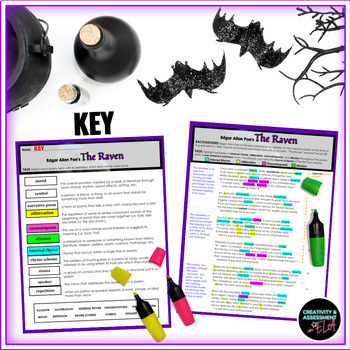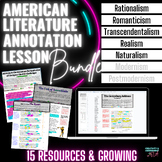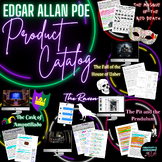The Raven Lesson | Annotation Poetry Activity for Comprehension & Poetic Devices
- Zip
- Easel Activity
What educators are saying
Also included in
- If you're moving chronologically through American literature, this collection of annotation lessons currently includes* texts from Rationalism/the American Revolution, Romanticism, Transcendentalism, Realism/the American Civil War, and Postmodernism. *Annotation lessons for Naturalism will be addedPrice $21.99Original Price $42.75Save $20.76
- Use these engaging, interactive print and digital resources to get your students excited to read "The Raven" and delve deeper into Edgar Allan Poe's life. Pre-teach poetic devices, allusions, and symbolism through the digital escape room, continue with the annotation lesson, and end with the assessmPrice $9.49Original Price $19.19Save $9.70
- Includes a collection of lessons, activities, escape rooms, and creative projects for Edgar Allan Poe's "The Raven," "The Cask of Amontillado," "The Pit and the Pendulum," "The Fall of the House of Usher," "Annabel Lee," and "The Masque of the Red Death." Any future Edgar Allan Poe products added tPrice $29.95Original Price $71.62Save $41.67
Description
Print and digital options included! Students highlight and annotate to analyze and demonstrate reading comprehension of Edgar Allan Poe's narrative poem with a focus on (1) the plot, (2) rhyme scheme, (3) internal rhyme, (4) alliteration, (5) onomatopoeia, and (6) allusions.
This product includes an annotation friendly version of Edgar Allan Poe's poem. Free versions of this public domain text are readily available in many locations, but this particular document gives students space to annotate along the margins.
In order to enact this lesson, you will need your students to have at least 4 different color highlighters.
I am a huge proponent of highlighting and annotating, and I try to have students interacting with the text as much as possible. Instead of answering a bunch of questions after they finish reading the poem, I prefer to have students work through the poem in a hands-on, interactive way. Just answering questions is boring. You'll be surprised how much more time annotating the poem takes, but in the end, the students will have a deeper understanding, will have done more work, and they won't even have realized it! It's amazing how adding highlighters is such a game changer.
Reading "The Raven" once or twice rarely gives students a true understanding of the story within this narrative poem and how the speaker's interaction with the raven changes drastically from beginning to end.
I generally begin this poem study by first, reading the poem, second, showing students The Simpson's Treehouse of Horror visual version of the poem, and last, having students read through the poem to highlight/annotate: (1) the plot of the narrative poem, (2) rhyme scheme, (3) internal rhyme, (4) alliteration, (5) onomatopoeia, and (6) allusions.
Generally, I model the first 4 stanzas with the students and allow them to annotate the remainder of the poem alone or with a partner.
The goal shouldn't necessarily be for students to identify every single instance of alliteration (if they miss one example, who cares?!). Rather, this exercise should train them to be more cognizant of the use of these poetic devices, so in the future, they can analyze poetry more deeply on their own.
If you would like The Raven vocabulary quiz that corresponds with the bolded words in the document, you can locate that item HERE!
Once you feel students are comfortable analyzing a poem like The Raven as practice, I would use one or both of the following poetry assessments to see how well students can analyze poetry independently:
The Tide Rises, The Tide Falls Poetry Analysis Assessment
Paul Revere's Ride Poetry Analysis Assessment
Related Products:
"The Raven" Text Message Activity | Digital | Distance Learning
"The Raven" Digital Escape Room - *Pre/Post-Reading* No Prep | Distance Learning
"The Raven" Vocabulary Quiz: Synonym, Antonym, Analogy, Fill-In-The-Blank
Other Edgar Allan Poe Materials:
The Pit and the Pendulum Lesson Bundle
A Creative Project for The Cask of Amontillado - Create an Original Coat of Arms"
"Cask of Amontillado" Study Guide & William Blake's "A Poison Tree" QuickWrite (FREE)









